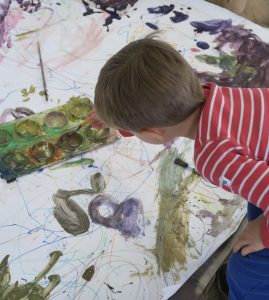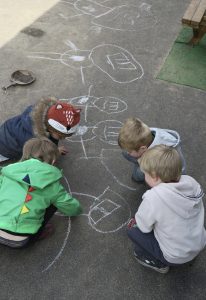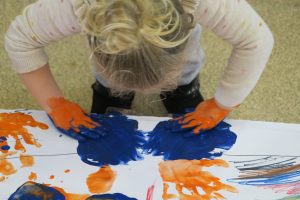Embracing the process
Personal growth through art
Children’s art can provoke many reactions but there is so much more going on  under the surface than what can be seen. Art allows children to reconstruct and assimilate their experiences and observations, to create meaning to the world around them. Especially for those who are just beginning to learn how to read and write, as shapes and symbols become a communication tool and a personal language.
under the surface than what can be seen. Art allows children to reconstruct and assimilate their experiences and observations, to create meaning to the world around them. Especially for those who are just beginning to learn how to read and write, as shapes and symbols become a communication tool and a personal language.
Adults often judge children’s art by adult standards, assessing it on its execution. However what a child creates is a unique representation of their own experiences and development. Children are able to produce artwork with distinctive qualities that no adult can replicate.
Journey of discovery
 Children are often shown the ‘right’ way when learning numbers and letters, whereas art opens up a world of possibilities where diversity and individuality can be celebrated. There may be a temptation for educators to fix, provide templates or insist all children follow the same objective. But this extinguishes the activation of creativity and invention, whilst subconsciously enforcing the notion that there is a ‘right’ way to do art.
Children are often shown the ‘right’ way when learning numbers and letters, whereas art opens up a world of possibilities where diversity and individuality can be celebrated. There may be a temptation for educators to fix, provide templates or insist all children follow the same objective. But this extinguishes the activation of creativity and invention, whilst subconsciously enforcing the notion that there is a ‘right’ way to do art.
In contrast, the Reggio Emilia approach we implement at Inspirations allows children to explore new materials and mediums by themselves, for themselves. Keeping the environment and activity open-ended provides children the freedom and responsibility to make their own decisions. Materials are thoroughly explored, skills and knowledge are repeated and reinforced in their own time, and children become masters of their own learning. Children can put in to practice the ‘hundred languages’, communicating, expressing and creating a dialogue of their own… one which is rich and colourful and not limited to an adult’s expectation.
 The process of a creation is equally a process for the child. Simple scribbles can be a representation of an object in action or an experiment on pressure and shape. Figures and shapes can become parts of a narrative that slowly emerge. Therefore, when a child is put at the centre of their learning they feel empowered and encouraged to fully immerse themselves in their process rather than fixating on the outcome. Ideas of right and wrong fade away and curiosity and discovery take precedence. Ultimately, providing the child harmony between body and soul, deepening their connection emotional, cognitively and physically to their sense of self.
The process of a creation is equally a process for the child. Simple scribbles can be a representation of an object in action or an experiment on pressure and shape. Figures and shapes can become parts of a narrative that slowly emerge. Therefore, when a child is put at the centre of their learning they feel empowered and encouraged to fully immerse themselves in their process rather than fixating on the outcome. Ideas of right and wrong fade away and curiosity and discovery take precedence. Ultimately, providing the child harmony between body and soul, deepening their connection emotional, cognitively and physically to their sense of self.
Julia Lai